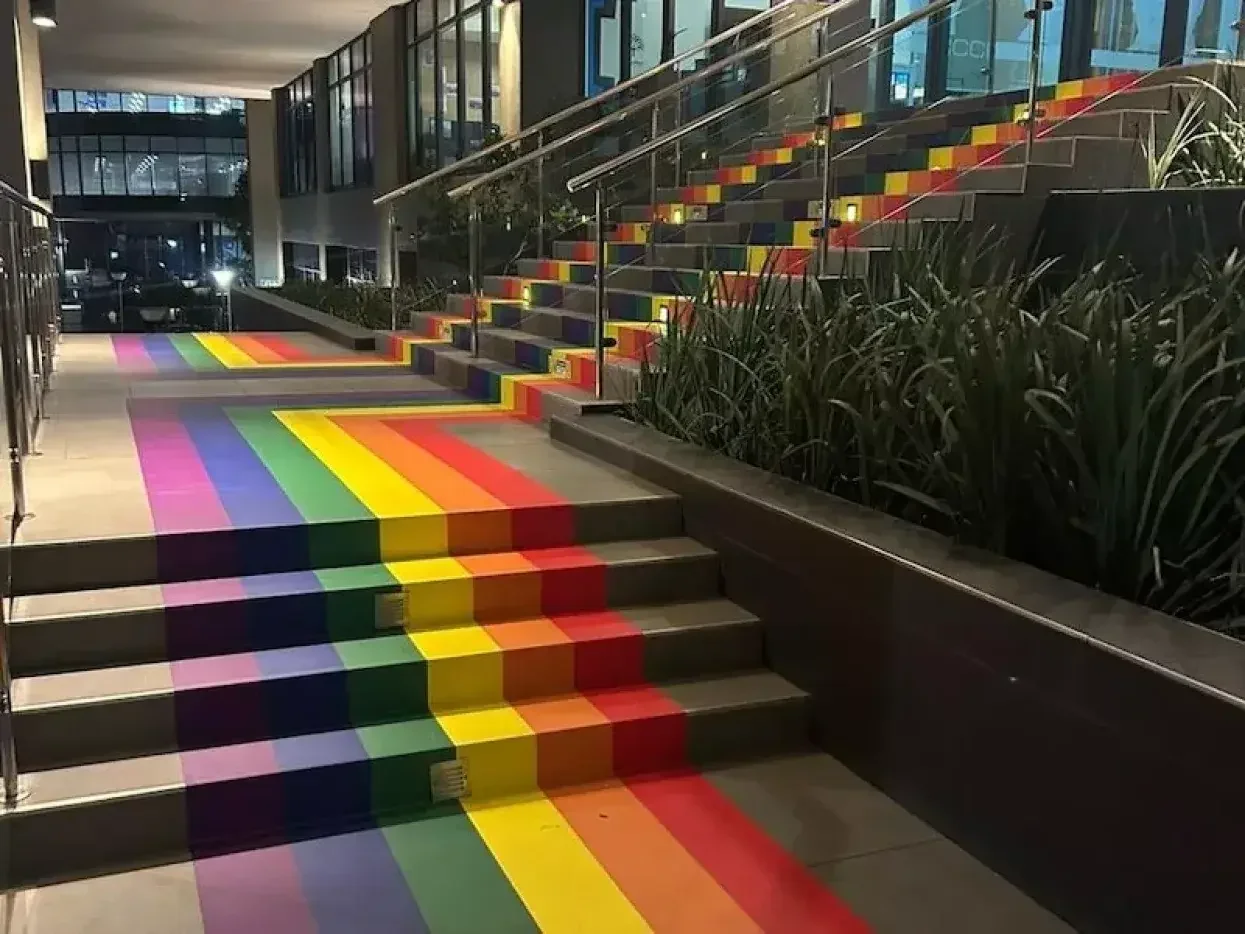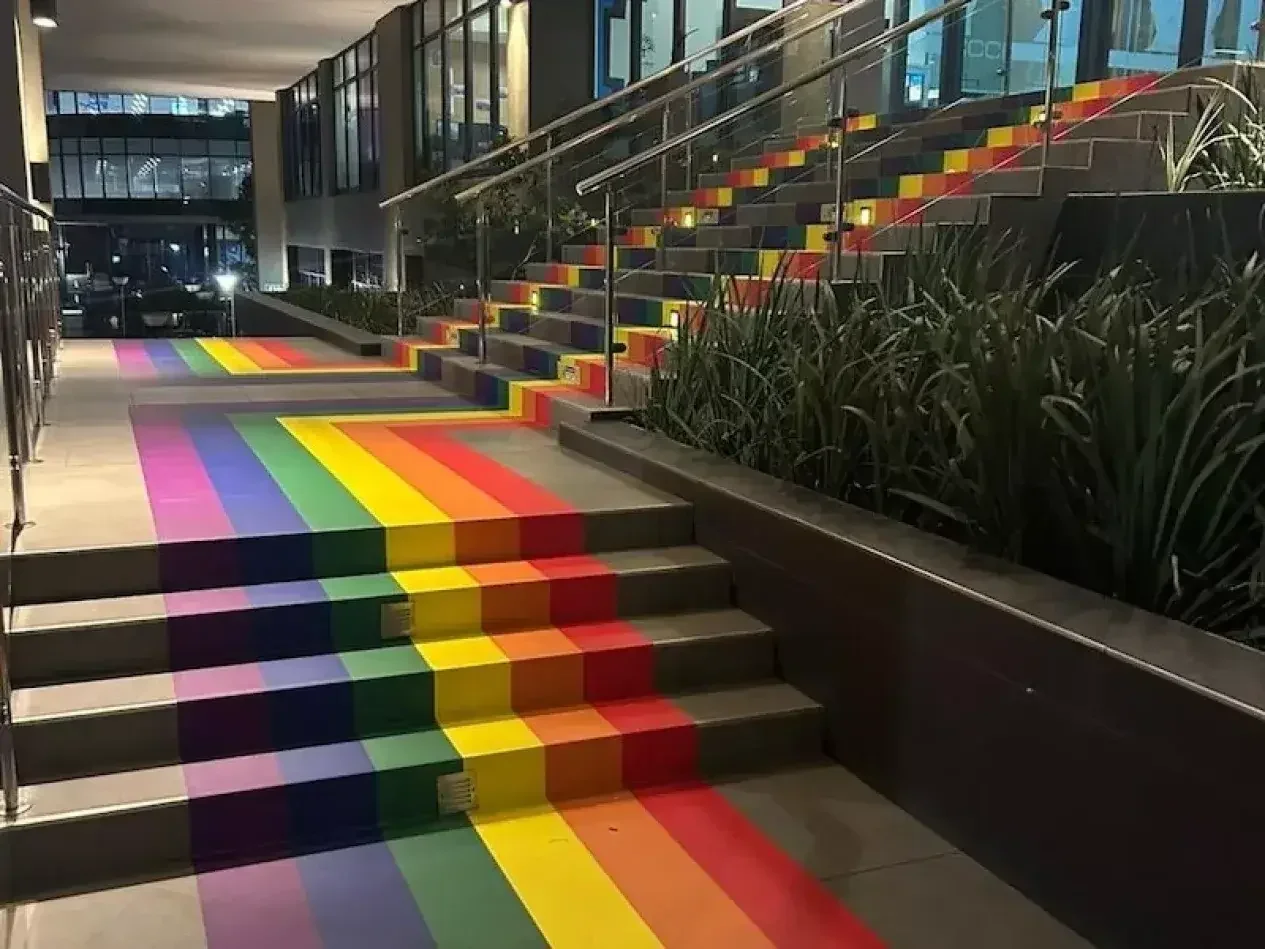
Nessan Cleary shares the opportunities offered by printed graphics on the floor and how it provides a different and valuable experience. He also discusses the factors that should be considered when selecting materials to print floor graphics.
Most people look straight ahead when walking and so it follows that most display graphics are placed on walls in the line of sight. But printed graphics on the floor can offer a different and equally valuable experience, and since people do also tend to look where they are walking, these graphics are guaranteed to be noticed. Floor graphics proved particularly useful in the Covid pandemic when many retailers and other public places relied on floor graphics to delineate 2m distances to help maintain social distancing and limit the spread of the virus.
Many years ago, when floor graphics first started to appear, people were worried that they might slip on the graphics, or would worry about damaging the graphic and simply avoid walking on them, creating bottlenecks in places such as supermarket aisles. But most people have become used to these graphics now, which are particularly good at directing foot traffic to certain areas, such as a special promotion.
There are a number of considerations to bear in mind when choosing materials to print floor graphics. Firstly, most media will be optimised to work on a specific surface, such as tiling or concrete. If you’re producing a lot of floor graphics, then it makes sense to keep a selection of media for each surface you might encounter. But otherwise, it might be more cost-effective to look for a media that will work on multiple surfaces to reduce the inventory that you carry. Many of the available media can also be used on walls, which is handy for those jobs where the design carries through from the floor to an adjacent wall.
Equally, while you want the graphic to bond with the surface when it’s installed, customers will not thank you if the graphic is hard to remove. You also have to be sure that the adhesive won’t damage the surface or leave any kind of mark after its removed. Some surfaces, such as waxed wooden boards are probably more trouble than they’re worth.
Safety is another major consideration as nobody wants to risk being on the wrong side of a lawsuit. Some substrates will have a non-slip surface, while others will have to be paired with an over-laminate that can both protect the graphic and add the required level of grip for people to walk on. You will also have to check that you have the correct certification for the location and type of use that the floor graphic is intended for, both in terms of slip resistance and fire resistance.
Another obvious factor is the length of time that the graphic is required for, which can include anything from a few days to support a particular promotional campaign or a semi-permanent installation as part of the way finding signage directing people around a building. Usually the laminate will be rated for specific periods, such as three months or one year. In addition, some areas may see much higher footfall than others and be subject to more wear and tear. It’s also essential that the graphic can withstand whatever cleaning process it’s likely to be subject to, especially in places such as hospitals or supermarkets where there may be more aggressive cleaning fluids in use.
Most flooring substrates are designed for indoor use, typically shops and museums, but there are some that can be used outdoors for applications such as wayfinding. These will usually have thicker adhesives to bond with concrete or pavements, as well as tougher laminates to cope with the weather and changes in temperature. This in turn may mean that you need a digital cutting table rather than a vinyl cutter to finish these graphics. At the very least, for both indoor and outdoor use, you should round off the corners to help the graphic last longer as right-angled corners are more likely to lift with use, which shortens the life of the graphic and creates a trip hazard.
There are a lot of different floor graphic media options available, far too many to list here. So we’ve picked out a small representative selection. Thus MX sells its PrismaFloor range, which is mainly designed for indoor use. The range includes a Clear version for printing shapes that are too complex to cut out easily. The Original variant lasts for up to three months, while the Gold option can last for up to 12 months.
This Soyang Grip Floor is a printable flooring substrate that comes with anti-slip certification.

Soyang sells a wide range of different types of substrates for floor graphics, including Cushioned Flooring, which is a PVC-coated polyester woven cushioned material that is said to resemble a linoleum material. It’s suitable for retail and exhibition uses and comes with a B1 fire rating. It comes in various widths up to 5m and can be printed with eco-solvent, latex and UV inks.
Grafityp offers a textured floor vinyl that includes a textured anti-slip layer and is rated for R10 slip resistance. There are two versions, one with a removable adhesive and another with high tack adhesive. They can be printed with eco-solvent, latex and UV inks. Both can be used on floors indoors, or on walls outside.
Inktec sells a Floor Graphic material that’s suitable for indoor use. It can be applied on various surfaces, including carpets and walls, and is certified for R12 slip resistance. It can be printed with eco-solvent, latex and UV inks and doesn’t require an additional laminate.
Prestige used Drytac’s Polar Grip with Prozac Floortex over laminate to create this staircase graphic.

DryTac has a number of different offerings for floor graphics, including Polar White, which is an 80 micron self adhesive PVC available in widths up to 1.5m. It can be used both indoors and outdoors, depending on the over laminate that’s used with it, which can give up to seven years outdoor use.
The South African print service provider Prestige used Polar Grip to create a rainbow-coloured floor graphic to help celebrate Pride Month. This was installed on stairs leading up to the busy front entrance area of the client’s building so Prestige used Protac Floortex 200 PVC over-laminating film to protect the graphics from heavy footfall up and down the stairs. The job was printed on a HP Latex 800W machine.
Belinda Lotter, Chief Executive Officer for Prestige, explained: “With the product being installed on stairs that have high traffic throughout the day, we needed a tough, consistent product that could take the stress while also being safe to walk on. The slip rating of the Floortex laminate and the aggressive adhesive of Polar Grip made these the perfect products for our and our client’s needs. Polar Grip also has excellent printing properties on our printer; the vivid ink colours are amazing and make the rainbow shades look just incredible.”
In conclusion, there’s plenty of choice in terms of floor graphics materials for different locations and applications. You will have to be aware of the relevant safety regulations for each location but this level of expertise also makes floor graphics a useful way to distinguish yourself from other print service providers in the area.